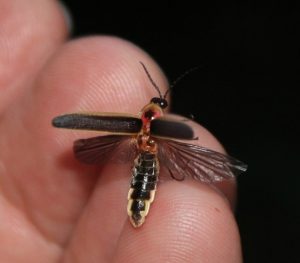
I love this time of the year! I have fond memories of summer freedom and evenings out in the yard catching lightening bugs, doing unspeakable things like trying to see how many it took so one could read a book by their light. I never found out. My fascination still hold though. Despite the 88o F temperatures, I go out into the yard to enjoy the spectacle. For decades, I wrote them all off as lightening bugs. Eventually, I learned that many different types of fireflies could be found near my home. But, how to tell the difference? They make it somewhat easy as each species has a distinct flash pattern and time frame.
At 8:00 PM, in my yard, the big dippers, Photinus pyralis, come out. Undoubtedly, this species fed my hunter instinct when I was a child. They are big, live in lawns, have a bright yellow light that stays lit for a relatively long time, once they flash they hang around for a couple seconds hoping for a response from a receptive female, and then move off to a new location where they make their
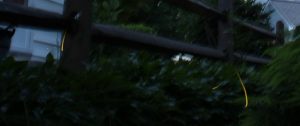
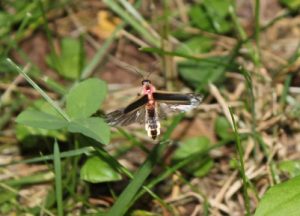
next “J” shaped flash. This species stays relatively close to the ground and is active most of the summer. Most children know this species by experience. This is the child’s firefly. The come out about twenty minutes before sunset while it is still bright outside and before a child’s curfew. Around here, they seem to peak around the fourth of July, providing a natural series of fireworks.
It comes as no surprise that this was the first western hemisphere firefly named by Linnaeus. Back in 1758 in his seminal work Systema Naturae Linnaeus called it Cantharis pyralis (Cantharis means a type of beetle and pyralis is a scientific word created from the Greek word for fire—pyr—and the latin suffix alis which means pertaining to). As more and more beetles were identified and named, the genus needed to be refined. LeConte changed the name to Photinus (shining). [1] [2]
As the evening progresses, these insects move further up the trees and their pattern changes to a more vertical pattern. But, I see other patterns.
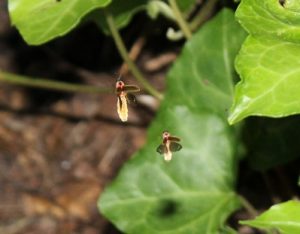
In my yard, I have spied at least four and maybe six different patterns of flashing. Out in the front, by the ivy, also early in the evening is a much smaller firefly with an oranger light. Unfortunately, I am not certain what it is. So, in frustration, I just purchased a copy of Lynn Frierson Faust’s book, Fireflies, Glowworms, and Lightening Bugs. How I have wanted a field guide like this! I took a picture and it makes me think that it is just a small dipper with a different flash pattern. I still need to work on this one!
Later in the evening, much higher in the trees, I watch a yellow-green, three-flash species. Looking at my new book, I see that only one species has such a pattern, Photuris versicolor. This species is another one commonly found in lawns and backyards. Most fireflies do not feed as adults but spend all their time trying to procreate. The fireflies in the genus Photurus (which translates to “light tail”) are an exception. Many of the females within this genus of fireflies feed on other fireflies. The can alter their response flash in an effort to attract a firefly of a different species or even its own for a meal. Versicolor can be translated by anyone who takes a few seconds to look at the word—variable colors. This species can do a wide array of patterns, but the three flash several second dark and three flash is diagnostic for this species.
I notice another, long extended horizontal flash high up in the trees, but it moves so fast I have not discerned enough of a pattern to make an identification.
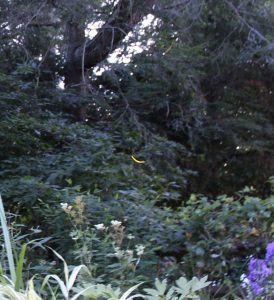
Now, I need to spend time really looking closely at the color, pattern and timing of the flashes. Plus, I will need to pay attention to how high, the firefly’s fly, what time of the night they flash (some are only flashing for a period of as brief as 20 minutes a day), the pattern of the flash, and the dates. Finally, I will need to explore more varied habitats than just my backyard. These clues will help me sort out the various species.
I see many fun evenings learning nature in my own backyard.
Reference:
[1] Faust, Lynn F. Fireflies, Glow-worms, and Lightening Bugs. University of Georgia Press, Athens, GA, 2017
[2] Borror, Donald J. Dictionary of Word Roots and Combining Forms. Mayfield Publishing Company, Palo Alto, CA. 1971.
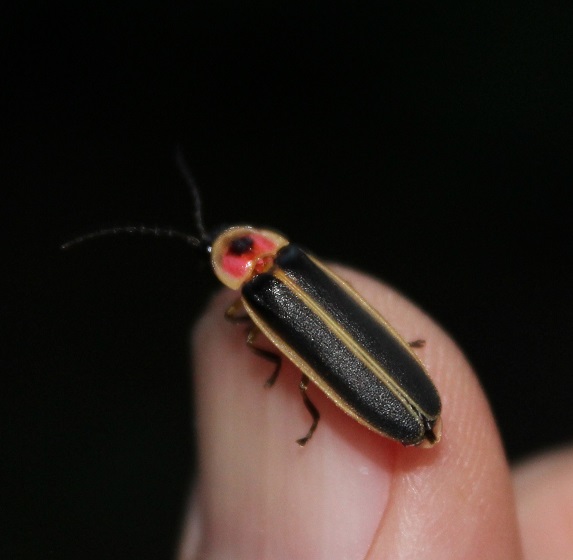
Comments
5 responses to “Enjoying the Light Show”
This is a wonderful article Bob. It reminds me of the comment of a lady who I know who has lived in Florida for the past 40 years. When she saw the fireflies in my Pennsylvania back yard she exclaimed, “I haven’t seen those since I was a child! I love them!” It never occurred to me that not everyone was so blessed to have such an entertaining light show.
There are actually more firefly species in Florida than here. I suspect your friend experience land use changes which eliminated her fireflies.
Last week the greenbelt behind my house was glowing with firefly lights!!
Beautiful isn’t it! I am just coming in from working on a new species and feeding some mosquitoes.
I don’t see too many here, but they are around right now putting on their show.